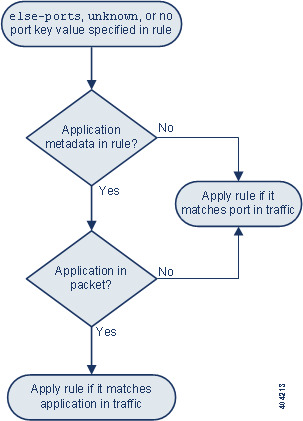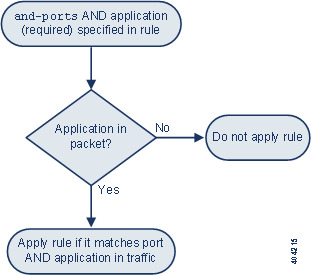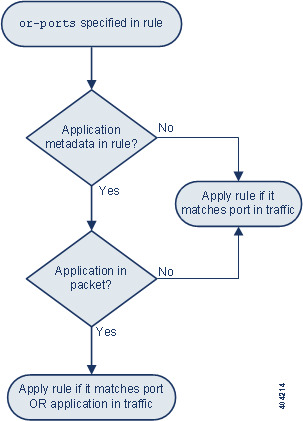Service Metadata
The system detects
applications running on the hosts in your network and inserts application
protocol information into your network traffic; it does this regardless of the
configuration of your discovery policy. You can use
metadata keyword
service arguments in a TCP or UDP rule to match
application protocols and ports in your network traffic. You can combine one or
more
service application arguments in a rule with a single
port argument.
Service Applications
You can use the
metadata keyword with
service as the
key and an
application as the
value to
match packets with the identified application protocol. For example, the
following
key value
argument in a
metadata keyword associates the rule with HTTP traffic:
service httpYou can identify multiple applications separated by commas. For example:
service http, service smtp, service ftpCaution | Adaptive profiling must be enabled (its default state) as described in Configuring Adaptive Profiles for intrusion rules to use service metadata. |
The following table describes the most common application values
used with the
service keyword.
Note | Contact Support for assistance if you have difficulty identifying applications
not in the table. |
|
Value |
Description |
|---|---|
|
|
Concurrent Versions System |
|
|
Distributed Computing Environment/Remote Procedure Calls System |
|
|
Domain Name System |
|
|
Finger user information protocol |
|
|
File Transfer Protocol |
|
|
File Transfer Protocol (Data Channel) |
|
|
Hypertext Transfer Protocol |
|
|
Internet Message Access Protocol |
|
|
Internet Security Association and Key Management Protocol |
|
|
My Structured Query Language |
|
|
NETBIOS Datagram Service |
|
|
NETBIOS Name Service |
|
|
NETBIOS Session Service |
|
|
Network News Transfer Protocol |
|
|
Oracle Net Services |
|
|
OS Shell |
|
|
Post Office Protocol, version 2 |
|
|
Post Office Protocol, version 3 |
|
|
Simple Mail Transfer Protocol |
|
|
Simple Network Management Protocol |
|
|
Secure Shell network protocol |
|
|
Sun Remote Procedure Call Protocol |
|
|
Telnet network protocol |
|
|
Trivial File Transfer Protocol |
|
|
X Window System |
Service Ports
You can use the metadata keyword with service as the
key and a specified port argument as the
value to define how the rule matches ports in
combination with applications.
You can specify any of the port values in the table below, one value per rule.
|
Value |
Description |
|---|---|
|
|
The system applies the rule if either of the following conditions is met:
The
|
|
|
The system
applies the rule if the packet application is known and matches the rule
application, and the packet port matches the ports in the rule header. You
cannot use
|
|
|
The system applies the rule if any of the following conditions are met:
|
Note the following:
-
You must include a
serviceapplication argument with theservice and-portsargument. -
If a rule specifies more than one of the values in the table above, the system applies the last one that appears in the rule.
-
Port and application arguments can be in any order.
Except for the
and-ports value, you can include a
service port argument with or without one or more
service application arguments. For example:
service or-ports, service http, service smtpApplications and Ports in Traffic
The diagrams below illustrate the application and port combinations that intrusion rules support, and the results of applying these rule constraints to packet data.
- Host application protocol else source/destination ports:
-

- Host application protocol and source/destination ports:
-

- Host application protocol or source/destination ports:
-

Example Matches
The following
sample rules using the
metadata keyword with
service arguments are shown with examples of data they
match and do not match:
-
alert tcp any any -> any [80,8080] (metadata:service and-ports, service http, service smtp;)Example Matches
Example Non-Matches
-
HTTP traffic over TCP port 80
-
HTTP traffic over TCP port 8080
-
SMTP traffic over TCP port 80
-
SMTP traffic over TCP port 8080
-
POP3 traffic on ports 80 or 8080
-
Traffic of unknown application on ports 80 or 8080
-
HTTP traffic on port 9999
-
-
alert tcp any any -> any [80,8080] (metadata:service or-ports, service http;)Example Matches
Example Non-Matches
-
HTTP traffic on any port
-
SMTP traffic on port 80
-
SMTP traffic on port 8080
-
Traffic of unknown application on port 80 and 8080
-
Non-HTTP and non-SMTP traffic on ports other than 80 or 8080
-
-
Any of the following rules:
-
alert tcp any any -> any [80,8080] metadata:service else-ports, service http;) -
alert tcp any any -> any [80,8080] metadata:service unknown, service http;) -
alert tcp any any -> any [80,8080] metadata:service http;)
Example Matches
Example Non-Matches
-
HTTP traffic on any port
-
port 80 if packet application is unknown
-
port 8080 if packet application is unknown
-
SMTP traffic on ports 80 or 8080
-
POP3 traffic on ports 80 or 8080
-